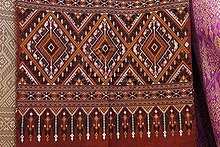User:Noppidki-randa.Chul
Phrae Wa:The local silk of Isan, The Northeastern region of Thailand.[edit]
“Phrae Wa”(Phrae Wa; Prae Wa,: แพรวา,ผ้าไหมแพรวา or แพรวากาฬสินธุ์) is hand-woven silk brocade with elaborate patterns traditionally on the deep red ground. It is generally used as a shawl. The cloth is part of Pu Thai culture – Pu Thai is a local community in the northeastern region Isan of Thailand. It is embroidered using Chok and Khit techniques. Chok is a weaving technique whereby the warp yarns are picked out by hand to weave discontinuous supplement weft..[1]' Chok means pick in Isan language (see also Teen Chok[1])). Khit is another weaving technique of handcrafting using a traditional loom..[2] Phrae Wa is considered the most valuable heritage and wisdom of Pu Thai community and an important product of Kalasin province in northeastern Thailand. The traditional size of this cloth is about one meter wide and four-meter long. The Pu Thai weaving style normally uses fingers to Chok (pull) the yarn.



Relations[edit]
"Pu Thai" community is an ethnic group originally immigrated from Southern China to the northeastern region of Thailand(Isan)for over a hundred years ago. The Phrae Wa fabric found more than a hundred years as well. A mural at Wat Udon Pracharat in Kalasin province depicting ways of life of Pu Thai ancestry shows that Phrea Wa was used as part of a costume of Pu Thai Culture.[3] Pu Thai people like to use Phrae Wa cloth to cover their shoulders or to wrap over one shoulder and around their chest and back. This way of wrapping is called Pha Bianng or Sa-bai in Thai language. Pu Thai women normally use this cloth when attending religious ceremonies, festivals, and special occasions. The wisdom of weaving “Phrae Wa” has been passed down from generation to generation and become the identity of “Pu Thai” ethnic group only.



Technique and Patterns[edit]
Phrae Wa cloth can be divided into two types: Pha Phrae Mon and Pha Phrae Wa. Pha Phrae Mon usually comes in square or rectangular shape. It is used as head cloth while Pha Phrae Wa is for shoulder covering. About the meaning of “Phrae Wa”, Phrae means cloth, and Wa is a Thai measurement unit of length. One Wa is equal to two meters. Thus, Phrae Wa is a piece of cloth which has a size of one Wa. “Phrae Wa” has intricate patterns requiring high weaving skill. The Phrae Wa pattern uses Chok, a technique that combines weaving and embroidering at the same time<https://encyclocraftsapr.com/pha-tin-chok//>, and Khit, a weaving technique using a continuous supplementary weft in geometric forms to create the patterns. The technique uses fingers to pick the threads without a needle or quill while weaving to create a bulging pattern on cloth. “Phrae Wa” is brocade that has sets of vertical threads (warp) and 'horizontal threads' (wefts) creating the fabric ground. An extra set of multicolored horizontal threads (supplementary weft) is used only for the patterns on fabric with a deep red ground to create colorful and various patterns. Each room of the Phrae Wa cloth contains different designs. The elaborate main pattern which is the most beautiful and complicated design is usually found at the center of the cloth. Phrae Wa pattern originated from Pha Saew which gathers all Phrae Wa patterns in a piece of cotton cloth. Pha Saew is a piece of white cotton that has the sample of Phrae Wa patterns. Each Phu Thai family normally has their own Pha Saew whose patterns are different from one another. The pattern on Pha Saew was originally created by family ’s ancestors and has been passed down as an inheritance from generation to generation.[5]

Development and Conservation[edit]
On November 29,1977. His Majesty King Bhumibol Adulyadej and Her Majesty Queen Sirikit visited Amphoe Khammuang,Kalasin province. H.M. Queen Sirikit noticed the cloth of Pu Thai women that has uniqueness. However, she saw a problem with this cloth.[6] The problem of Phrae Wa was that its traditional size was too narrow, and each piece of cloth was made differently in various patterns. This was quite difficult to find a matching pattern for clothing. The traditional cloth which was normally 35 to 40 centimeters wide was extended to one meter, then Phrae Wa cloth has become wider. “The idea of “extending a beater is to extend lives.” was truly initiated by Her Majesty Queen Sirikit. That means to extend the traditional size of “Phrea Wa” for commerce and adapt it for a variety of clothes. It can conserve the knowledge of this local fabric and develop to be the main career that increases the income of the local people. Presently “Phrae Wa” is one of many famous and successful projects of The Foundation for the Promotion of Supplementary Occupations and Related Techniques under the Royal Patronage of Her Majesty the Queen". The Foundation has made this local silk of the northeastern region of Thailand become well known.